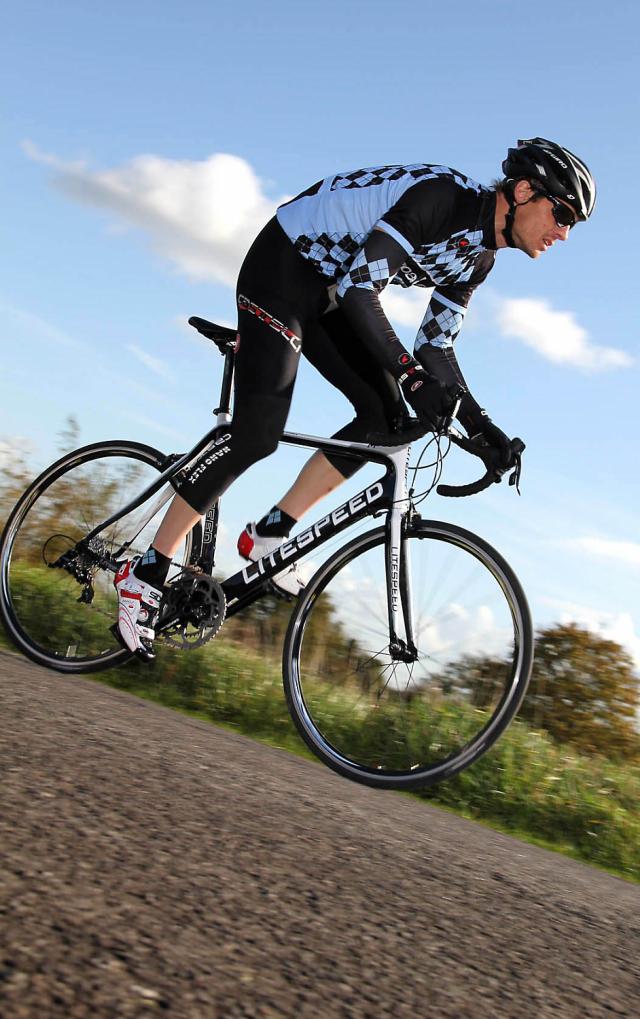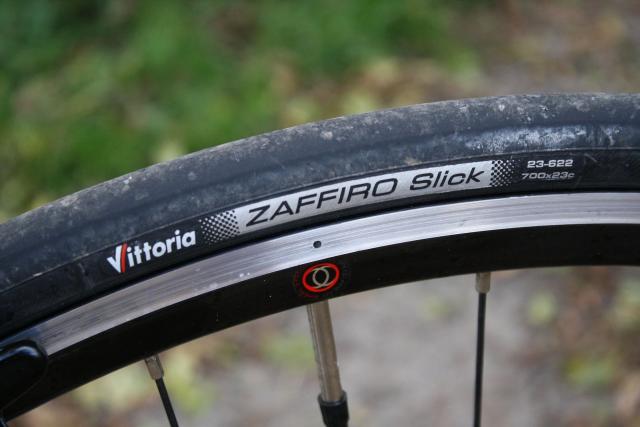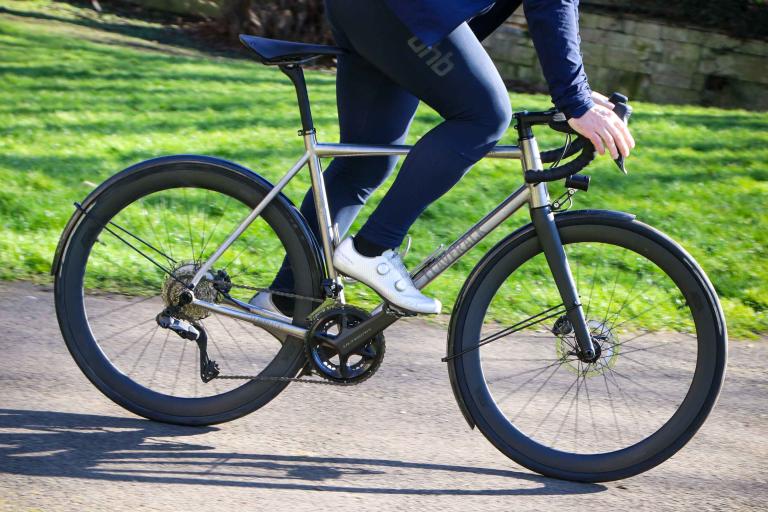- News
- Reviews
- Bikes
- Components
- Bar tape & grips
- Bottom brackets
- Brake & gear cables
- Brake & STI levers
- Brake pads & spares
- Brakes
- Cassettes & freewheels
- Chains
- Chainsets & chainrings
- Derailleurs - front
- Derailleurs - rear
- Forks
- Gear levers & shifters
- Groupsets
- Handlebars & extensions
- Headsets
- Hubs
- Inner tubes
- Pedals
- Quick releases & skewers
- Saddles
- Seatposts
- Stems
- Wheels
- Tyres
- Tubeless valves
- Accessories
- Accessories - misc
- Computer mounts
- Bags
- Bar ends
- Bike bags & cases
- Bottle cages
- Bottles
- Cameras
- Car racks
- Child seats
- Computers
- Glasses
- GPS units
- Helmets
- Lights - front
- Lights - rear
- Lights - sets
- Locks
- Mirrors
- Mudguards
- Racks
- Pumps & CO2 inflators
- Puncture kits
- Reflectives
- Smart watches
- Stands and racks
- Trailers
- Clothing
- Health, fitness and nutrition
- Tools and workshop
- Miscellaneous
- Buyers Guides
- Features
- Forum
- Recommends
- Podcast
review
£1,399.99
VERDICT:
Good, solid road bike that does everything it should, but it's decent value rather than a must-have bargain even at £1399 rather than £1999 RRP
Weight:
8,950g
Contact:
www.evanscycles.com
At road.cc every product is thoroughly tested for as long as it takes to get a proper insight into how well it works. Our reviewers are experienced cyclists that we trust to be objective. While we strive to ensure that opinions expressed are backed up by facts, reviews are by their nature an informed opinion, not a definitive verdict. We don't intentionally try to break anything (except locks) but we do try to look for weak points in any design. The overall score is not just an average of the other scores: it reflects both a product's function and value – with value determined by how a product compares with items of similar spec, quality, and price.
What the road.cc scores meanGood scores are more common than bad, because fortunately good products are more common than bad.
- Exceptional
- Excellent
- Very Good
- Good
- Quite good
- Average
- Not so good
- Poor
- Bad
- Appalling
Litespeed introduced the M1 a few months ago as the entry-level model in their carbon lineup. Although the M1 comes with a recommended retail price of £1,999.99 - call it two grand - Evans are selling it for £1,399.99, so that's the price at which we're reviewing it, can't see anywhere else you can buy it. Suffice to say it's not a big bargain at £1999.99.
The ride

The M1's ride is solid, but you wouldn't call it spectacular. Climb aboard and spin the cranks and it responds readily enough although the acceleration won't blow you away.
The M1 is a reasonable weight for a £1,400 bike - 8.95kg (19.7lb) in the case of our large sized test model. To put that in some sort of context, we tested a Giant TCR1 Compact (£1,175) earlier in the year and that was 8.8kg (19.4lb) and the £1,150 Vitus Dark Plasma was 8.8kg too.
Of course, the way a bike rides is about way, way more than the figure on the scales, but the weight does come into it. I'm not saying the Litespeed is in any way sluggish; I'm not saying that at all. It accelerates quickly... but no more quickly than lots of other bikes at this price.
You flick up through the gears via SRAM Apex shifters. Pretty much the whole groupset is Apex, which is SRAM's entry-level group: the mechs, chainset, brakes and the bottom bracket.

I'm guessing you know the deal when it comes to SRAM's Double Tap shifters by now but, just for the forgetful, everything is done via shift levers that sit behind the brake levers. The brake levers don't enter into the equation at all. A short sideways push moves the chain in one direction, a longer sweep moves it the other way.
Is it better or worse that Shimano or Campag? That really does come down to personal preference. A couple of people have recently told me that they've found SRAM needs more maintenance and adjustment than the other brands to keep it running smoothly, but that's not been my experience. I've not had to do spend any time keeping this Apex system happy over several weeks of heavy use. I might have had to turn a barrel adjuster on one of the down tube cable stops a couple of times, but that's it.
Anyway, let's not get too sidetracked on that just now. If you want to know the full deal on SRAM Apex, check out David Else's review of the complete groupset from earlier in the year.

The Litespeed's ride position is pretty traditional - it's a tried and tested format. As I said, our test model is a large and it has a 58cm seat tube and a 57cm top tube. The head angle is 73 and the seat angle is 73.5. There's nothing radical in any of that.
The head tube is 18cm giving a low front end. Litespeed haven't added any extra height up front to appeal to those wanting a more back-friendly setup. Well, that's not quite true... The aluminium FSA Omega Compact bars are, well, compact with a drop of 125mm rather than FSA's standard 150mm so it's not quite such a stretch to lower yourself down there.
Plenty of pro racers use a compact bar - again, it's just a matter of preference. I actually got on really well with this one. It's double-butted, stiff enough and FSA don't skimp on the rearward sweep so there's plenty of space to get a comfortable hand position.
The Velo saddle comes with a cutaway section in the centre to relieve pressure and it's successful in that. The shell that's left, though, is very flexible to the point that I felt the middle of the saddle was sagging and I had to move the seatpost up a touch to compensate. On the plus side, all that flex takes the pain out of any impact such as hitting a pothole or a raised manhole cover.
In fact, the M1 is a pretty comfortable bike all round as long as you're happy with the racy ride position. You don't get any particular road buzz through the fork while the back end copes with bumpy roads well.
Litespeed reckon this is because of the hourglass-shaped seatstays that sweep in, then out, then in again between the dropouts and the seat tube. I'd speculate that this shaping makes little, if any, difference, but the ride is smooth enough without isolating you totally from the road, so what does it matter?

That Apex chainset I mentioned earlier is a compact with 50 and 34-tooth chainrings while the 10-speed cassette ranges from 11-26. That gives you a small lowest gear for getting up the hills - although the mid-cage rear mech can handle anything up to a 32T. Fit one of those and you could climb trees. Even if you're a strong rider, it can be useful to have a large sprocket as a safety net to get you out of trouble on the last big hill of the day.
The M1 tackles the hills just fine. It's doesn't drift effortlessly skyward like some bikes but it's a willing assistant on the climbs. Get out of the saddle to wrestle as much power as possible onto the pedals and the frame holds firm.
road.cc's Big Dave rode the Litespeed on Garmin's Ride Out a few weeks ago and he earned that name (the 'Big' bit, not the 'Dave' bit; he was just given that). He's 6ft 3in and 100kg+ and he puts out a lot of power. Fair enough, that ride was mostly flat but there were a couple of steep climbs in it and Dave reported nothing amiss with regard to flex.
The Apex brakes provide all the bite needed to keep you fully in control too. They're positive and progressive and it's easy to get the power on whether you're on the hoods or the drops.
The frame

Check out the M1's frame and you'll get a good idea why it can handle Dave's strong arm tactics. The down tube is 63mm high and 47mm across up by the head tube, and it broadens out at the bottom bracket. The top tube is meaty and the chainstays are big and boxy where they connect with the BB area too - 49mm high if you want to put a figure on it. There are plenty of chunkier frames out there - and looks can be deceptive - but the M1 is certainly built to give as good as it gets.
The frame is a unidirectional carbon monocoque with a 3K weave at the top. The head tube isn't tapered, it houses 1 1/8in bearings at both the top and bottom and the bottom bracket is a screw-in external job rather than a BB30 or any of those other standards that are kicking about these days. The fork has straight carbon legs while the steerer tube is alloy.
The components

As I said earlier, the groupset is SRAM Apex which you'll also find, for example, on a £999 Specialized Secteur Elite and on a £1,899 Cannondale SuperSix. There aren't many Apex-equipped bikes out there at £1,999 (the M1's retail price) but there are more at £1,399 (the price at which Evans are selling the M1).
The bar, stem and seatpost are aluminium offerings from FSA and the wheels come from the same brand. They're RD-60s and they'd cost you about £160 for the pair if you bought them separately.
These aren't the highest quality wheels ever but they do the job. They're 25mm deep and pretty heavy (well over 2kg for the pair, plus skewers) which dulls the acceleration somewhat, but they run smoothly enough on loose ball bearings, and the plain-gauge Sapim spokes hold them firm. The front wheel could do with a little of truing after several weeks of use, but that's a two minute job with a spoke key so no worries there.
I'll be honest: I'm not a fan of the Vittoria Zaffiro Slick tyres. They're heavy and lifeless. The grip is okay but if this was my bike they'd be off PDQ. In fact, if you really want to pep up the ride, whack some lighter wheels on. I often say that, and it's often true.
Verdict
Good, solid road bike that does everything it should, but it's decent value rather than a must-have bargain even at £1399 rather than £1999 RRP
road.cc test report
Make and model: Litespeed M1
Size tested: Size large
About the bike
State the frame and fork material and method of construction. List the components used to build up the bike.
Frame: Unidirectional monocoque carbon frame with an elite level 3K weave
Fork: Unidirectional monocoque carbon
Front Derailleur: SRAM Apex
Rear Derailleur: SRAM Apex
Levers: SRAM Apex
Chainset: SRAM Apex Compact, 50/34 tooth chainrings
Bottom Bracket: SRAM Apex
Cassette: SRAM PG950, 11-26 tooth, 10-speed
Chain: SRAM PC1031
Front Brake: SRAM Apex
Rear Brake: SRAM Apex
Handlebars: FSA Omega Compact
Stem: FSA OS-190
Headset: FSA Orbit IS
Wheels: FSA RD-60
Tyres: Vittoria Zaffiro
Saddle: Velo
Seatpost: FSA SL-250
Tell us what the bike is for, and who it's aimed at. What do the manufacturers say about it? How does that compare to your own feelings about the bike?
Litespeed say, "New for 2011, the Litespeed M1 SRAM Apex bicycle. Featuring an elite unidirectional monocoque carbon frame and fork usually reserved for bicycles unavailable at this price point, the M1 exudes dollar-for-dollar performance and value. Box-section profile at the bottom bracket ensures optimum power transfer while unique, flattened aero-shaped down tube improves wind flow. Reliable as the day is long, super fast, and set for a solid day of racing or training, the M1 competes at every level."
It's a solid road bike for the price -I just don't think there's anything here that sets it apart from the crowd.
Frame and fork
Overall rating for frame and fork
7/10
Tell us about the build quality and finish of the frame and fork?
All good. No little imperfections or weirdness to worry about and the paint job is both attractive and well done.
Tell us about the materials used in the frame and fork?
The frame is unidirectional carbon with a 3K weave at the top. The fork is the same with an alloy steerer.
Tell us about the geometry of the frame and fork?
See body of the review. It's a traditional-style road bike geometry with an almost horizontal top tube and mid-length head tube.
How was the bike in terms of height and reach? How did it compare to other bikes of the same stated size?
Normal for a road bike of this size.
Riding the bike
Was there any toe-clip overlap with the front wheel? If so, was it a problem?
Yes, a small amount. Caught the front of my shoe on the tyre a couple of times but not a problem
How would you describe the steering? Was it lively, neutral or unresponsive? Neutral
Rate the bike for efficiency of power transfer:
8/10
Rate the bike for acceleration:
7/10
Rate the bike for sprinting:
7/10
Rate the bike for high speed stability:
7/10
Rate the bike for low speed stability:
7/10
Rate the bike for flat cornering:
7/10
Rate the bike for cornering on descents:
7/10
Rate the bike for climbing:
7/10
The drivetrain
Rate the drivetrain for performance:
7/10
Rate the drivetrain for durability:
8/10
Rate the drivetrain for weight:
7/10
Rate the drivetrain for value:
7/10
Wheels and tyres
Rate the wheels and tyres for performance:
7/10
Rate the wheels and tyres for durability:
7/10
Rate the wheels and tyres for weight:
6/10
Rate the wheels and tyres for comfort:
7/10
Rate the wheels and tyres for value:
7/10
Controls
Rate the controls for performance:
7/10
Rate the controls for durability:
8/10
Rate the controls for weight:
7/10
Rate the controls for comfort:
9/10
Rate the controls for value:
7/10
Your summary
Did you enjoy riding the bike? Yes
Would you consider buying the bike? Hmm, it's good but not great
Would you recommend the bike to a friend? As above
Rate the bike overall for performance:
7/10
Rate the bike overall for value:
7/10
Anything further to say about the bike in conclusion?
Just to point out that my value mark is based on what you can actually buy it for, £1399 rather than the rrp £1999 the mark would be significantly lower if based on that
About the tester
Age: 40 Height: 190cm Weight: 74kg
I usually ride: My best bike is:
I've been riding for: Over 20 years I ride: Most days I would class myself as: Expert
I regularly do the following types of riding: time trialling, commuting, sportives, general fitness riding,
Mat has been in cycling media since 1996, on titles including BikeRadar, Total Bike, Total Mountain Bike, What Mountain Bike and Mountain Biking UK, and he has been editor of 220 Triathlon and Cycling Plus. Mat has been road.cc technical editor for over a decade, testing bikes, fettling the latest kit, and trying out the most up-to-the-minute clothing. He has won his category in Ironman UK 70.3 and finished on the podium in both marathons he has run. Mat is a Cambridge graduate who did a post-grad in magazine journalism, and he is a winner of the Cycling Media Award for Specialist Online Writer. Now over 50, he's riding road and gravel bikes most days for fun and fitness rather than training for competitions.



























and "Motorist with 176 penalty points still driving on UK's roads, DVLA figures show"
Pretty sure it's often the case that - even where we add cycle infra at all - it's not uncommon that even the minimum width suggested by the...
Well, I guess it's all in how you deliver it, right?
People don't 'need' the big expensive cars either, but people like nice things....
and the la vie claire team kit, really the only acceptable non-pro use of pro colour schemes.
An excellent plan. In fact the Church Road site has parking spaces for rent from time to time, which are snapped up, though not quite as quickly as...
Eventually managed to get my hands on these, ordered from Cycling 2000 (looks like a few other UK shops also have them)....
My brother bought me this mug - no occasion, just "saw this and thought of you".
It will be even worse to read when the missing bottle cages are added.